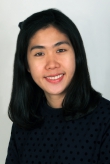Prof. Dr. Michael Naumann

Prof. Dr. Michael Naumann
Project Leader
Project 1, Project 9, Project 15
P1-1: Helicobacter pylori infection and gastric barrier function
Phatcharida JantareePhD Student
Michael NaumannProject Leader |
The development of a chronic inflammation in the stomach can be triggered by H. pylori, thus the human pathogen is a risk factor for gastric diseases including gastric cancer. The H. pylori-induced transcription factor nuclear factor kappa-light-chain-enhancer of activated B cells (NF‑kB) is involved in the pro-inflammatory response and cell survival in the gastric mucosa, and represents a trailblazer of gastric pathophysiology. H. pylori infection is not restricted to the epithelial cell populations, but due to cellular interactions within a specific disease-promoting micromilieu involve, e.g. subepithelial myofibroblasts. In order to identify suitable therapeutic targets and diagnostic markers for the prevention and treatment of chronic gastric diseases, we plan to identify intra- and intercellular signaling mechanisms promoting a maladaptive response at the epithelial gastric barrier. These studies will scrutinize the role of NF-κB (cooperation with Project 10 and Project 11) and deubiquitinylases, and modulation of protein-expression via the ubiquitin-proteasomal system. In systematic approaches we intend to study whole gastric tissue arrays from H. pylori infected patients (gastritis → adenoma → adenocarcinoma), aiming to identify DUBs as specific molecular pathologic biomarkers. The identified factors involved in H. pylori-associated chronic gastric diseases will be selected for detailed mechanistic studies using in vitro co-culture systems combining epithelial cells or gastric organoids, e.g. with myofibroblasts (cooperation with Associated Project 2, Associated Project 4 and Project 6). Drug design using biomolecular modeling/computational chemistry and preclinical efficacy tests will be conducted to evaluate the potential therapeutic value of potential novel targets.
H. pylori crosstalk with mucosal epithelial cells, fibroblasts etc. The molecular gastric pathology studies address the role of DUBs, e.g. A20, USP47 in H. pylori-induced NF-κB-dependent chemokine release and cell survival. The chronic inflammatory micromilieu and maladaptive processes will be studied in biopsies from patients. Explanted cells from patient material will be differentiated in pit- and gland-type organoids to perform knockdown of DUBs prior to infection. To investigate the crosstalk of epithelial gland-type cells with LEndoC, co-cultures will be analyzed in Boyden chamber and microfluidic devices. |
Photos: by UMMD, Melitta Schubert/Sarah Kossmann
P1-2: USP48-dependent regulation of NF-kB and cell survival in the infected gastric mucosa
Lorena FerinoPhD Student
Michael NaumannProject Leader |
The human pathogen Helicobacter pylori the is a risk factor for gastric diseases including gastric cancer. H. pylori colonizes the gastric epithelium and the disease-promoting microenvironment involve, e.g. subepithelial fibroblasts. The H. pylori-induced transcription factor nuclear factor kappa-light-chain-enhancer of activated B cells (NF‑kB) is involved in the pro-inflammatory response and cell survival in the gastric mucosa, and represents a trailblazer of gastric pathophysiology. In order to identify suitable therapeutic targets and diagnostic markers for the prevention and treatment of chronic gastric diseases, we plan to identify intra- and intercellular signaling mechanisms promoting a maladaptive response at the epithelial gastric barrier. These studies will scrutinize the role of NF-κB (cooperation Project 11-2, Project 13-2 and MD 8) and deubiquitinylases (DUBs), and modulation of protein-expression via the ubiquitin-proteasome system. The impact of DUBs on maladaptive processes in the gastric mucosa (microenvironment) will be investigated by co-culture of gastric monolayer organoids and fibroblasts in the Boyden chamber and in microfluidic devices. Factors relevant for the maladaptation will be identified in the secretome and the metabolome of the cells and assessed in knockout cells (cooperation Project 12-2, Project 13-2 and Project 14-2). In addition, the expression of NF-kB and DUBs will be analyzed in whole gastric tissue arrays from patients with B-type gastritis and chronic gastritis.
H. pylori-induced cellular crosstalk in the gastric mucosa. Molecular pathological studies of the stomach address the role of deubiquitinylases (DUBs), e.g. USP48, in H. pylori-induced NF-kB activity and H. pylori-associated apoptotic cell death in the gastric mucosa. Maladaptive processes in the gastric microenvironment are investigated by co-culture of gastric monolayer (2D) mucosoids and fibroblasts in the Boyden chamber (static conditions) and in microfluidic devices (fluid flow conditions). Factors relevant for the maladaptation will be identified in the secretome and the metabolome of the cells and assessed in knockout cells. |
Photos: by UMMD, Melitta Schubert/Sarah Kossmann
P9-1: Unfolded protein response (UPR) in diabetic kideny disease and H. pylori infected gastric mucosa
Shruthi KrishnanPhD Student Yanfei YuPhD Student
Berend IsermannProject Leader
Michael NaumannProject Leader |
Diabetic nephropathy (dNP), now the most common cause of chronic renal disease, is characterized by dysfunctional barriers in the glomerular and tubular compartments. A common cell type found in both renal compartments are pericytes, which interact with epithelial (EpiC) and endothelial (EndoC) cells. Maladaptive pericyte activation impairs barrier function and promotes kidney fibrosis, a common final pathway in kidney damage. Targeting pericyte function may allow protection of both renal compartments. However, specific strategies to target pericytes are currently lacking. TEM1 (tumor endothelial marker 1, CD248, or endosialin) is a protein expressed by pericytes in various organs, including the kidney and the stomach. Expression of TEM1 is high during development in tumors and during inflammatory diseases. In a clinical study low TEM1 expression by cancer associated fibroblast correlates with increased survival of gastric cancer patients. However, the mechanisms underlying TEM1-dependent effects remain poorly defined. In cooperative work (Project 7) we analyzed TEM1 regulation and the unfolded protein response (UPR) and established a role of TEM1 in renal pericytes in the context of dNP. We hypothesize that pericyte derived TEM1 co-ordinately regulates barrier function in chronic diseases. Specifically, we define the molecular mechanism and functional consequences of intracellular signaling via TEM1 between pericytes and barrier-defining epithelial cells, and conduct a structure function analyses of TEM1 to identify the molecular structures required for barrier regulation to determine whether modulating TEM1 function allows to rescue epithelial cells and thus barrier function. Two PhD students jointly address questions about the regulation of the UPR in the context of renal cells (Shruthi Krishnan) and H. pylori-infected gastric mucosal cells (Yanfei Yu).
UPR regulation in DKD and H. pylori infection. (A) TEM-1 expressing cells in the kidney (blue; mesangial cells, top, and peritubular pericytes, bottom) interact with endothelial cells (red), podocytes (yellow, top), and tubular cells (yellow, bottom). (B) Schematic diagram of UPR signalling. |
Photos: by UMMD, Melitta Schubert/Sarah Kossmann
P15-2: Exploitation of epithelial/endothelial microenvironment crosstalk
Sandro GogiaPhD Student
Michael NaumannProject Leader |
Helicobacter pylori is a risk factor in the pathogenesis of various gastroduodenal diseases including gastric cancer. The complexity of the gastric environment makes it difficult to analyze the plethora of cellular processes initiated upon infection. The intricacy of the system stems from the interconnection between the colonized epithelilal cells, the stroma cells (fibroblasts) and angiogenic and lymphangiogenic endothelial cells. To elucidate the cellular crosstalk, we will devise a triple co-culture system comprising of gastric epithelial cells, fibroblasts and endothelial cells, thus mimicking the in vivo gastric environment. We study the impact of H. pylori-induced nuclear factor kappa-light-chain-enhancer of activated B-cells (NF-κB) and Wnt/b-catenin-signaling on inflammation. Prominent regulators of the NF-κB system comprise the therapeutically relevant group of deubiquitinylases (DUBs). The effects of DUBs on NF-κB are examined and evaluated in knockdown/knockout cells. Furthermore, within secretomes, we will investigate the relevant factors involved in maladaptations and metabolic disorders. We anticipate that exploiting the interplay between the above cellular processes will help to understand the key mechanisms of chronic infection.
H. pylori-induced epithelial and endothelial microenvironment crosstalk in the gastric mucosa. Molecular pathological studies of the stomach address the importance of crosstalk in the gastric mucosa upon H. pylori infection. The maladaptive processes in the gastric microenvironment are investigated by tri-culture of NCI-N87, HGF and HUVEC cells. Factors relevant for the maladaptation will be identified in the secretome and assessed in the knockout/knockdown cells. |
Photos: by UMMD, Melitta Schubert/Sarah Kossmann
P15-3: Modes of Helicobacter pylori-induced NF-κB activity in the gastric mucosa
|
Arun KanthasamyPhD Student
Michael NaumannProject Leader |
Helicobacter pylori is a type I carcinogen and a known risk factor for several gastroduodenal diseases, including gastric cancer. We investigate several effectors leading to the activation of classical nuclear factor kappa-light-chain-enhancer of activated B-cells (NF-κB) by H. pylori. ADP-glycero-b-D-manno-heptose (ADP-Hep) has been characterized as the virulence factor that induces rapid and short-lived NF-κB activity. However, less in known about the activity of NF-κB during long-term H. pylori infection within the gastric mucosa. The study of the gastric microenvironment is challenging due to the complexity of the numerous cellular processes that are initiated during infection. The main cross-talk in the gastric microenvironment happens between epithelial cells, fibroblasts and endothelial cells. To characterize the NF-κB-dependent cellular cross-talk, we will use a triple co-culture system to mimic the conditions in the gastric microenvironment. Herein, we will also use isogenic mutants of H. pylori as well as knockdown and knockout cell lines. We expect that the triple co-culture system in combination with the isogenic mutants of H. pylori should help us to understand the different mechanisms by which H. pylori induces pro-inflammatory NF-κB signaling in the gastric microenvironment.
|
Photos: by UMMD, Melitta Schubert/Sarah Kossmann
AP2: Role of STAMBPL1 in cell survival in gastric mucosa
|
|
The human pathogen Helicobacter pylori, a risk factor for gastric diseases, induces the transcription factor NF-κB leading to a pro-inflammatory response and cell survival. These processes are regulated by a variety of deubiquitinylating enzymes (DUBs), which are overexpressed or mutated in a variety of cancer types. STAM-binding protein-like 1 (STAMBPL1, also called AMSH-2 and AMSH-LP) belongs to family proteins of JAMM DUBs that cleaves Lys63 ubiquitin linkage. However, the functions of STAMBPL1 and target proteins have not yet been understood. In order to scrutinize the roles of STAMBPL1, we aim to identify the mechanisms of STAMBPL1 function in H. pylori-infected gastric epithelial cells and at epithelial gastric barriers. In our functional studies, STAMBPL1 depletion causes apoptotic cell death accompanied by caspase 8 and PARP-1 cleavage as well as a decrease in the abundance of XIAP and surviving in non-stimulated HeLa cells, but not in non-stimulated AGS and NCI-N87 cells. Interestingly, H. pylori infection led within 16 h to the degradation of STAMBPL1 through K48 ubiquitinylation. Therefore, it is of interest to identify which E3 ligases regulate this process. Further, the molecular crosstalk of the infected epithelial barrier with the mucosa cells (fibroblasts and lymphangiogenic endothelial cells) and the consequences for the micromilieu will be studied. To investigate the roles of STAMBPL1 homeodynamics and dysregulation in gastric barrier function, we plan to analyze the influence of STAMBPL1 on the secretome of the micromilieu (fibroblasts and endothelial cells) in the gastric mucosa during H. pylori infection. Secreted factors which induce proliferation and survival will be identified and addressed in detail in co-culture system. The impact on angiogenesis of endothelial cells in response to the secretome of H. pylori-infected epithelial cells will be also studied. In order to study the maladaptive inflammatory processes, we plan to study the inflammation in STAMBPL1-depleted epithelial cells and the impact on the micromilieu using primary gastric organoid cultures (cooperation with MPI Berlin, University of Dresden). In long-term culture, the impact of immune response mediators on cell survival will be studied by qPCR, multiplex cytokine assay and monitoring of apoptotic cell death factors.
STAMBPL1 in cell survival and crosstalk with gastric mucosa during H. pylori infection. Roles of STAMBPL1 on cell survival, gastric barrier function and maladaptive response will be addressed in detail. |
Photos: by UMMD, Melitta Schubert/Sarah Kossmann
MD8: H. pylori-induced stress response signaling in the gastric mucosa
|
|
The human pathogen Helicobacter pylori colonises the gastric epithelium and is a risk factor for gastric diseases including gastric cancer. The disease-promoting microenvironment involves, e.g. subepithelial fibroblasts. In order to characterize maladaptive responses at the epithelial gastric barrier we plan to study the H. pylori induced stress response signaling including p38, JNK and IKK activity and their role in cell survival. These studies will scrutinize the role of transcription factor nuclear factor kappa-light-chain-enhancer of activated B cells (NF‑kB) and activator protein 1 (AP-1) (cooperation Project P1-2 and Project 11-2). The role of stress response signaling for maladaptive processes in the gastric microenvironment will be investigated by co-culture of gastric carcinoma cells (NCI-N87) or gastric monolayer organoids, and fibroblasts in the Boyden chamber. Factors relevant for the maladaptation will be identified in the secretome of the cells (cooperation Project 12-2). H. pylori-induced stress response signaling in the gastric mucosa. The studies in gastric carcinoma cells (NCI-N87) or gastric monolayer organoids address the role of stress response signaling (p38, JNK, IKK) in H. pylori-associated apoptotic cell death. Maladaptive processes in the gastric microenvironment are investigated by co-culture of NCI-N87 cells or gastric monolayer organoids and fibroblasts in the Boyden chamber. Factors relevant for the maladaptation will be identified in the secretome of the cells. |
Photos: by UMMD, Melitta Schubert/Sarah Kossmann





























